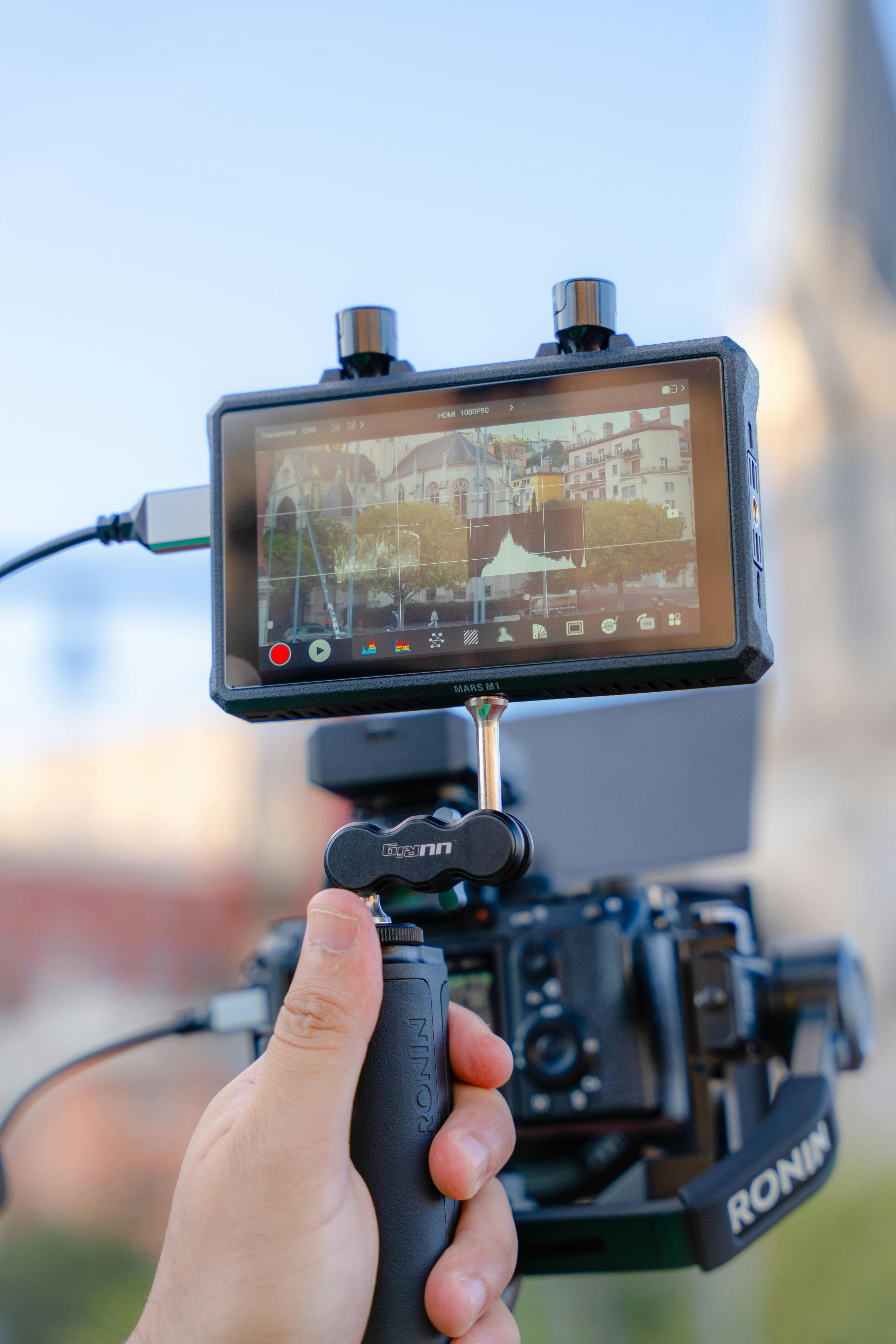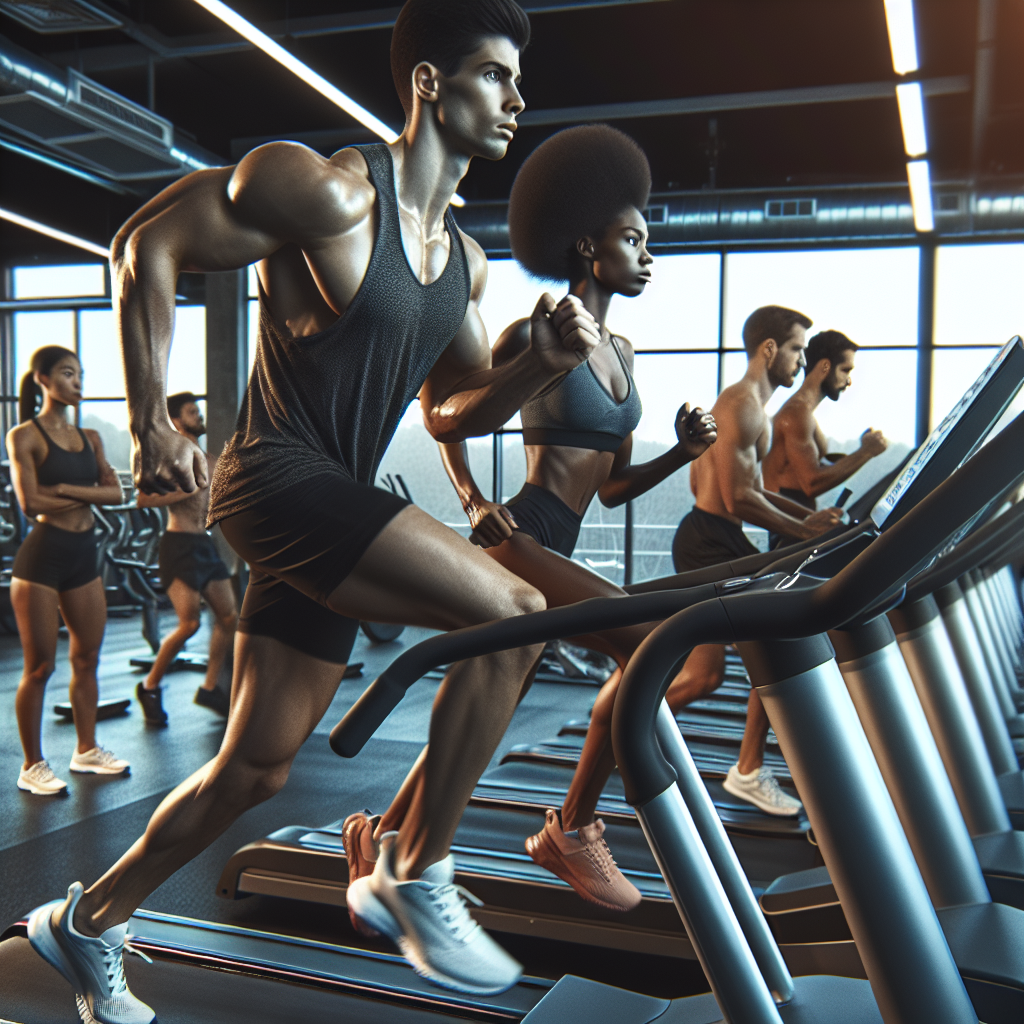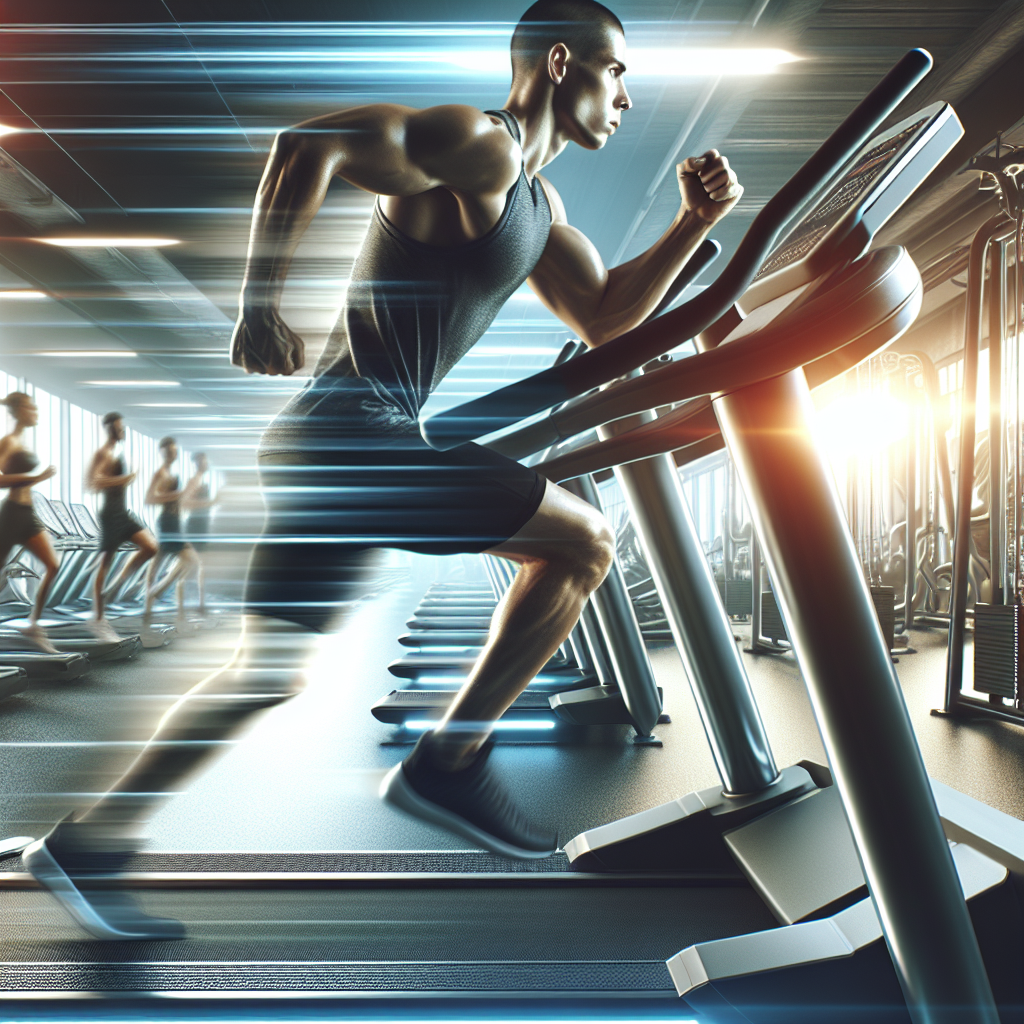The fast-paced world of modern fitness demands efficient and effective machines that cater to the diverse needs of gym-goers. Among these, the ultimate sprint machine stands out as a powerful tool for achieving explosive speed and cardiovascular endurance. In this article, I will explore the various features of the sprint machine, compare its costs, and ultimately highlight its significance in the realm of gym equipment. Whether you are an avid athlete or someone seeking to enhance your fitness level, the sprint machine is an indispensable asset that delivers unparalleled results.
The Benefits of Sprint Machines

Improved Cardiovascular Fitness
Sprint machines are a wonderful tool for enhancing cardiovascular fitness. By engaging in sprint workouts, individuals can increase their heart rate, improve their lung capacity, and strengthen their cardiovascular system. This results in a more efficient supply of oxygen and nutrients to the body’s tissues, promoting overall cardiovascular health. Additionally, sprint training helps to improve endurance, allowing individuals to sustain high-intensity exercise for longer durations.
Increased Muscle Power and Endurance
Another significant benefit of sprint machines is the development of muscle power and endurance. Sprinting engages the major muscle groups in the body, including the quadriceps, hamstrings, glutes, and calves. The repeated explosive movements of sprinting strengthen these muscles, leading to increased power and endurance. This is particularly beneficial for athletes who rely on bursts of speed and power, such as sprinters, soccer players, and basketball players.
Enhanced Speed and Agility
Sprint machines are renowned for their ability to enhance speed and agility. By regularly incorporating sprint workouts into their training routines, individuals can improve their sprinting mechanics, increase their stride length, and boost their overall speed. Moreover, sprint training helps to develop agility, which is crucial for quick changes in direction and rapid acceleration. Athletes in sports like football, tennis, and rugby can greatly benefit from improved speed and agility acquired through sprint machine training.
Low Impact on Joints
For individuals seeking an effective cardiovascular workout with minimal impact on the joints, sprint machines are an excellent choice. Unlike activities such as running on hard surfaces, sprint machines provide a controlled and cushioned environment that reduces the stress placed on the joints. This makes sprint machine workouts ideal for individuals with joint concerns or those recovering from injuries, as they can still engage in high-intensity exercise while minimizing the risk of further joint damage.
Time Efficiency
In today’s fast-paced world, time efficiency is a crucial factor when it comes to exercise. Sprint machines offer a time-efficient workout option, allowing individuals to maximize their training sessions in a shorter amount of time. Compared to other cardiovascular exercises like jogging or cycling, sprint workouts on machines like treadmills or rowing machines require fewer minutes to achieve comparable cardiovascular benefits. This aspect is particularly beneficial for individuals with busy schedules or those looking to make the most of their limited workout time.
Types of Sprint Machines
There are several types of sprint machines available in gym settings, each offering unique features and benefits to cater to individual preferences and training goals. Some of the most commonly found sprint machines include:
Treadmills
Treadmills are perhaps the most well-known and widely used sprint machines in gyms. They consist of a moving belt that allows users to simulate running or walking while remaining in a stationary position. Treadmills often offer incline and speed adjustment options, enabling users to customize their workouts according to their fitness levels and training goals.

Elliptical Trainers
Elliptical trainers provide a low-impact yet effective full-body workout. These machines simulate motions similar to cross-country skiing, combining upper and lower body movements. They are designed to minimize stress on the joints, making them suitable for individuals with joint issues or those looking to avoid high-impact exercises.
Stationary Bikes
Stationary bikes, also known as exercise bikes or spin bikes, are a popular choice for cardiovascular workouts. These machines offer a seated cycling experience and come with adjustable resistance levels to increase the intensity of the workout. Stationary bikes are particularly beneficial for individuals seeking a lower-body focused sprint workout.
Stair Climbers
Stair climbers, as the name suggests, simulate the experience of climbing stairs. These machines provide an intense lower-body workout by engaging the quadriceps, hamstrings, glutes, and calves. Stair climbers often include customizable resistance settings and speed options to cater to different fitness levels.
Rowing Machines
Rowing machines, also known as ergometers or rowers, offer a comprehensive full-body workout. They simulate the motion of rowing a boat and engage both the upper and lower body muscle groups. Rowing machines are excellent for building strength and endurance while providing a low-impact exercise option.
VersaClimbers
VersaClimbers, although less common in gyms, are gaining popularity for their ability to provide an intense full-body workout. These machines simulate climbing motions, engaging the muscles of the arms, legs, and core. VersaClimbers offer the benefit of both cardiovascular and strength training, making them a versatile sprint machine option.
Factors to Consider When Choosing a Sprint Machine
When selecting a sprint machine, it is important to consider various factors to ensure it aligns with your needs and preferences. These factors include:
Space and Size
The available space in your home or gym is an important consideration when choosing a sprint machine. Treadmills and elliptical trainers often require a larger footprint, whereas stationary bikes or compact rowing machines may be more suitable for limited spaces.

Budget
The cost of a sprint machine is another critical factor to consider. Prices can vary significantly depending on the brand, features, and quality of the machine. It is essential to establish a budget range and compare options to find a sprint machine that meets your requirements without stretching your finances.
Specific Training Goals
Your specific training goals should guide your choice of sprint machine. Consider whether you are primarily focused on cardiovascular fitness, muscle power, endurance, or overall body strength. Different machines offer varying degrees of emphasis on these aspects.
Features and Technology
Sprint machines come with a range of features and technological advancements. These can include adjustable incline levels, programmable workouts, heart rate monitors, touchscreens, and connectivity options. It is beneficial to assess which features are important to you and align with your fitness goals.
Brand and Warranty
The reputation of the brand and the warranty provided can offer insights into the quality and durability of the sprint machine. Researching and comparing different brands and their warranty policies can help ensure a reliable and long-lasting investment.
Treadmills
Overview and Functionality
Treadmills are one of the most common and versatile sprint machines available in gyms. They consist of a motorized belt that allows individuals to walk, jog, or run while remaining in a stationary position. Treadmills typically offer adjustable speed and incline settings to simulate various terrain and intensities.
Price Range
The price range for treadmills can vary significantly depending on factors such as brand, features, and overall quality. Entry-level treadmills can be found in the range of $500 to $1000, while high-end models with advanced features can cost upwards of $5000.

Pros and Cons
Pros
- Versatile and suitable for individuals of different fitness levels.
- Allows for customization of speed and incline to create personalized workouts.
- Provides a familiar and natural running or walking motion.
- Often equipped with various training programs and entertainment options.
- Offers easy tracking of metrics such as distance, time, and calories burned.
Cons
- Requires a larger footprint compared to other sprint machines.
- Can be noisy during operation.
- Continuous impact may not be suitable for individuals with joint issues.
- Higher-end models can be quite expensive, limiting affordability for some.
Elliptical Trainers
Overview and Functionality
Elliptical trainers, also known as cross-trainers, provide a low-impact yet effective full-body workout. These machines mimic the motion of cross-country skiing and combine movements of the upper and lower body. Elliptical trainers feature pedals and handlebars that work synchronously to engage both the arms and legs.
Price Range
The price range for elliptical trainers varies depending on factors such as brand, features, and overall quality. Entry-level elliptical trainers can be found in the range of $500 to $1000, while advanced models with additional features and enhanced durability can cost upwards of $3000.
Pros and Cons
Pros
- Low-impact exercise option suitable for individuals with joint concerns.
- Works multiple muscle groups simultaneously, providing a comprehensive workout.
- Adjustable resistance levels offer the ability to customize the intensity.
- Can provide a challenging cardiovascular workout while minimizing stress on the joints.
- Can be used in both forward and reverse motions, targeting different muscle groups.
Cons
- May take time to adapt to the unique motion of elliptical training.
- Requires a larger space compared to some other sprint machines.
- Some models may have limited stride length options, which may not suit individuals with longer strides.
- Advanced features and enhanced durability may come at a higher price.
Stationary Bikes
Overview and Functionality
Stationary bikes, also referred to as exercise bikes or spin bikes, provide a seated cycling experience while remaining in a stationary position. These machines come with pedals, handlebars, and a comfortable seat to mimic the motion of outdoor cycling. Stationary bikes often offer adjustable resistance levels to increase the intensity of the workout.
Price Range
The price range for stationary bikes can vary depending on factors such as brand, features, and overall quality. Entry-level models can cost around $200 to $500, while premium bikes with advanced features and durability can go up to $3000 or more.

Pros and Cons
Pros
- Provides a low-impact workout that is gentle on the joints.
- Mimics the motion of outdoor cycling, making it suitable for cycling enthusiasts.
- Adjustable resistance levels offer the ability to customize the intensity.
- Can be used for both seated and standing workouts.
- Many models come with additional features such as built-in workout programs and wireless connectivity.
Cons
- Primarily focuses on lower-body muscles, with minimal engagement of the upper body.
- Can be less effective for individuals seeking a comprehensive full-body workout.
- Seated position may cause discomfort for some individuals over extended workout durations.
- Entry-level models may lack certain features or durability found in higher-end bikes.
Stair Climbers
Overview and Functionality
Stair climbers simulate the experience of climbing stairs, offering a high-intensity lower-body workout. These machines consist of revolving steps that move up and down in a continuous motion. Stair climbers often have adjustable settings that allow users to increase or decrease the speed and resistance to tailor the intensity of the workout.
Price Range
The price range for stair climbers can vary depending on factors such as brand, features, and overall quality. Entry-level models can be found in the range of $1000 to $2000, while commercial-grade stair climbers with advanced features and enhanced durability can cost upwards of $5000.
Pros and Cons
Pros
- Provides an intense cardiovascular workout while targeting the lower body muscles.
- Simulates the motion of climbing stairs, offering a functional fitness element.
- Adjustable speeds and resistance levels allow for customization of the workout intensity.
- Often includes additional features such as heart rate monitoring and pre-programmed workouts.
- Suitable for individuals seeking a high-intensity, leg-focused workout.
Cons
- Primarily engages lower-body muscles, with minimal upper body involvement.
- Continuous stepping motion may take time to adapt to for some individuals.
- Larger size and footprint compared to some other sprint machines.
- Entry-level models may lack some advanced features found in higher-priced options.
Rowing Machines
Overview and Functionality
Rowing machines, also known as ergometers or rowers, provide a full-body workout by simulating the motion of rowing a boat. These machines consist of a seat, footrests, and a handle connected to a resistance mechanism. Rowing machines engage both the upper and lower body muscles, including the back, arms, legs, and core, making them a versatile sprint machine option.
Price Range
The price range for rowing machines varies depending on factors such as brand, features, and overall quality. Entry-level rowing machines can be found in the range of $500 to $1000, while high-end models with advanced features and enhanced durability can cost upwards of $2000.
Pros and Cons
Pros
- Offers a comprehensive full-body workout, engaging multiple muscle groups.
- Low impact exercise option suitable for individuals with joint concerns.
- Promotes both cardiovascular fitness and strength development.
- Adjustable resistance levels allow for customization of the workout intensity.
- Simulates a natural and rhythmic rowing motion, providing a functional fitness element.
Cons
- Requires proper technique to execute the correct rowing motion.
- Some individuals may find the seat and footrests uncomfortable over extended durations.
- Larger size and footprint compared to certain sprint machines.
- Higher-end models with advanced features may be relatively expensive.
VersaClimbers
Overview and Functionality
VersaClimbers are unique sprint machines that simulate climbing motions to provide a high-intensity full-body workout. These machines consist of handles and foot pedals that move synchronously, engaging the arms, legs, and core muscles. VersaClimbers offer the benefits of both cardiovascular and strength training in a single workout session.
Price Range
The price range for VersaClimbers can vary depending on factors such as brand, features, and overall quality. Prices for home-use models typically start around $2000, while commercial-grade options with additional features and durability can cost upwards of $5000.
Pros and Cons
Pros
- Provides a high-intensity full-body workout, engaging multiple muscle groups simultaneously.
- Minimizes stress on the joints while offering effective cardiovascular exercise.
- Offers adjustable resistance levels to customize the workout intensity.
- Works arms, legs, and core muscles, promoting overall strength development.
- Suitable for individuals seeking a challenging and dynamic workout experience.
Cons
- Unique climbing motion may require adaptation and practice.
- Generally higher in price compared to other sprint machines.
- Larger size and footprint may not be suitable for limited spaces.
- May not be as widely available in all gym settings.
Additional Considerations for Sprint Machine Usage
In addition to choosing the right sprint machine, there are several important considerations to optimize your sprint machine workouts:
Proper Warm-up and Cool Down
Prior to using a sprint machine, it is crucial to warm up the muscles and prepare the body for the upcoming exertion. A dynamic warm-up routine that includes gentle movements and stretches can help increase blood flow and flexibility. Similarly, ending the workout with a cool-down, involving static stretches and gradual reduction in intensity, helps prevent muscle soreness and promotes recovery.
Adjusting the Settings and Intensity
To achieve the desired benefits from sprint machine workouts, it is essential to adjust the settings and intensity according to your fitness level and training goals. Gradually increasing the speed, incline, or resistance levels over time will challenge the body and ensure ongoing progress. Conversely, if a workout feels overly challenging or leads to discomfort or pain, it is important to decrease the intensity and make appropriate adjustments.
Monitoring Heart Rate and Tracking Progress
Monitoring heart rate during sprint machine workouts provides valuable feedback on the intensity and effectiveness of the exercise. Many sprint machines come equipped with heart rate monitors, or individuals can use wearable fitness trackers or chest strap monitors. Tracking heart rate allows for better control and optimization of the workout intensity. Keeping a record of workout duration, speed, distance, and other metrics can also help monitor progress and provide motivation.
Incorporating Sprint Workouts into a Training Routine
Sprint machine workouts can be incorporated into a comprehensive training routine to maximize results. For cardiovascular fitness, it is recommended to perform sprint workouts at least two to three times a week, with adequate rest days in between. Varying the duration, intensity, and type of sprint machine used can add diversity and prevent monotony. It is also advisable to combine sprint machine workouts with strength training exercises to promote overall fitness and muscular balance.
In conclusion, sprint machines offer numerous benefits for individuals seeking to improve cardiovascular fitness, increase muscle power and endurance, enhance speed and agility, and minimize joint impact. Treadmills, elliptical trainers, stationary bikes, stair climbers, rowing machines, and VersaClimbers represent various options available in gym settings, each with its own unique features and functionalities.
When choosing a sprint machine, factors such as available space, budget, specific training goals, features and technology, as well as brand reputation and warranty should be considered. Treadmills provide versatility and customization, elliptical trainers offer low-impact full-body workouts, stationary bikes focus on lower-body cardiovascular exercise, stair climbers provide intense leg-focused workouts, rowing machines offer comprehensive full-body workouts, and VersaClimbers deliver challenging climbing motions.
To optimize sprint machine workouts, it is important to warm up and cool down properly, adjust settings and intensity, monitor heart rate and track progress, and incorporate sprint workouts into a well-rounded training routine. By considering these factors and incorporating sprint machine workouts effectively, individuals can reap the benefits of improved cardiovascular fitness, increased muscle power and endurance, enhanced speed and agility, while minimizing the impact on joints, all within a time-efficient exercise routine.
